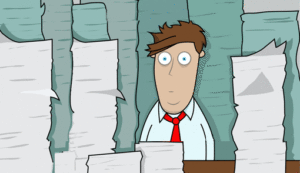We look at how to run a contact centre without using paper.
Paper is no longer a necessary commodity in modern call centres. In fact, paper now acts like dust – accumulating around any call centre that is neglected and behind the times.
It’s not easy, but orchestrating a complete paper-cleanse can reap a lot of benefits, some of which cut to the very core of your working culture and the way it is perceived.
Why go paper-free?
Banishing paper from your call centre will make your processes faster, reduce errors and reduce costs. It will make your office much more neat and tidy, plus it is eco-friendly.
It also makes PCI compliance and data protection much less of a headache.
Those are the benefits you can actually measure. Beyond that, though, it symbolises a proactive culture – to anyone who sees or hears that you work paper-free, you are immediately perceived as running a clean, efficient, dynamic operation.
Step into any office that works with that infuriating ‘we’ve always done it this way’ ethos and there is one thing you are guaranteed to see – loads and loads of paper.
Here is how you start getting things off the page and onto the screen:
No more notepads or post-its
This is the single biggest step you can take to eliminate paper from your call centre.
There is no need for any agent to be taking handwritten notes. If you have Microsoft Outlook, then use the ‘notes’ function to write directly onto screen. If you don’t have Outlook then there is a Windows accessory called ‘sticky notes’, which is just as good.
Why sit there typing up notes from a pad when you can just cut and paste? If each agent saves 30 seconds on each call, that makes a huge difference over time.
Scan all documents
With all incoming mail, it is important to make sure it doesn’t reach the main floor of the office. If you have all your scanned documents linked into your CRM system, then the process for all incoming mail should be simple: open it, scan it and shred it.
Circulate training notes by email only
One of the quickest ways to accumulate paper is to give countless ‘hand outs’ in training sessions. These then get pinned up, filed away, lost in drawers or left on desks.
These documents, like incoming mail, should be made easily accessible through your CRM system, but if you must circulate them, do it by email. Then ensure you carry out this next step:
Lock down the printer
Make sure that the printer is not openly accessible, or your agents will have those training notes printed out and pinned up next to their family photos within minutes.
Letters to customers
Outgoing customer letters is one area that has to be printed, there’s no way around that. So keep the process quick and contained, just like the incoming mail – print it, put a stamp on it and mail it.
Kicking the habit
It’s a natural fact of call centres that some agents will embrace change and progress, whereas others will have to be dragged, kicking and screaming.
For anyone whose performance starts to plummet purely through paper-withdrawal symptoms, give them a white board to take notes on.
White boards
White boards are a great way to replace paper and can be very useful for quickly writing down a customer’s name or account number – particularly if you have to do a lot of jumping around from one computer screen to another. The small ones are fairly cheap, although you would need a plentiful supply of pens.
And finally…
Make sure everyone knows how to move text on-screen
It sounds simple, but this is where you really make the gains once your office is paper-free.
Where your agents were once scribbling out notes onto pads and taking an age to type them up, they can now CTRL+C, CTRL+V, select all, drag and drop – this is what hacks down your after-call work and keeps mistakes to a minimum.
Also, without relying on training notes plastered all over desks, agents soon get far more familiar with the layout of your CRM software, finding things faster and registering changes as soon as they occur.
Paper has served us well for many centuries, but in the modern call centre, it is now a sign of a working culture that is stuck in the past.

Matt Phil Carver
PS We suggest that you don’t print off this article.
With thanks to Matt Phil Carver – a regular contributor to Call Centre Helper.
Author: Megan Jones
Published On: 28th May 2014 - Last modified: 18th Aug 2025
Read more about - Call Centre Management, Management Strategies, Matt Phil Carver















